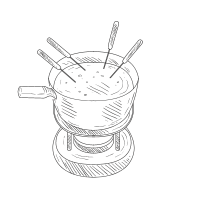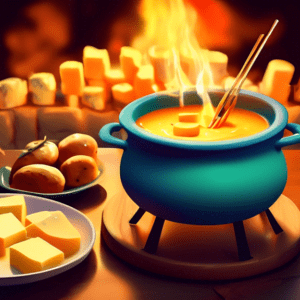What is Fondue?
Fondue, a culinary delight that embodies convivial dining, finds its roots
in the heart of Switzerland. More than just a meal, fondue is an experience,
a celebration of shared moments and delicious simplicity. But what exactly
is fondue? At its core, fondue is a dish where small pieces of food,
typically bread or meat, are skewered onto long, thin forks and dipped into a
communal pot of simmering liquid kept warm over a portable stove. The heat
of the pot gently cooks the dipped morsels, while the accompanying sauces
and sides provide a symphony of flavors.
A Brief History of Fondue
Fondue’s history is as rich and varied as the cheeses used in its
preparation. While its exact origins remain a subject of debate, the dish
finds its roots in 18th-century Switzerland, particularly in the Jura
Mountains and the Alps. In these mountainous regions, cheese and bread were
staple foods, readily available and easily preserved. Fondue, with its
ingenious method of using heat to transform these humble ingredients into a
satisfying and communal meal, quickly gained popularity among farmers and
shepherds.
The word fondue itself originates from the French verb fondre, meaning
to melt, which perfectly encapsulates the essence of the dish. Early
versions of fondue involved melting together stale cheese with wine, using
heat to create a smooth and flavorful sauce for dipping bread. As fondue’s
popularity spread throughout Switzerland and beyond, variations on the
original recipe emerged.
Types of Fondue
The world of fondue extends far beyond the classic cheese variety. Over
time, culinary innovation has given rise to a tantalizing array of fondue
styles, each with its own unique character and appeal. Let’s delve into
some of the most popular types:
1. Cheese Fondue
No exploration of fondue would be complete without paying homage to the
classic: cheese fondue. This timeless favorite typically features a blend of
Swiss cheeses, such as Gruyère and Emmental, melted together with dry white
wine, garlic, and a touch of Kirsch (cherry brandy). The result is a
velvety smooth and irresistibly cheesy dip that pairs perfectly with crusty
bread, steamed vegetables, and pickled gherkins.
2. Meat Fondue (Fondue Bourguignonne)
For those who prefer savory indulgences, meat fondue, also known as Fondue
Bourguignonne, offers a delightful alternative. In this style of fondue,
a pot of hot oil is kept simmering at the table. Diners then spear bite-sized
pieces of tender meat, such as beef, chicken, or seafood, onto their forks
and cook them to their liking in the hot oil. A variety of dipping sauces,
from creamy béarnaise to tangy mustard, complement the richness of the meat.
3. Chocolate Fondue
No fondue feast would be complete without a touch of sweetness. Chocolate
fondue is the perfect way to end a meal on a high note. This decadent treat
typically involves melting together high-quality chocolate with cream and
liqueur. The result is a luxurious and decadent dip that’s perfect for
coating an array of treats, such as fresh fruit, marshmallows, pound cake,
and brownies.
Essential Equipment for Fondue
Creating the perfect fondue experience requires the right tools. Here’s a
rundown of the essential equipment you’ll need:
1. Fondue Pot (Caquelon)
The heart of any fondue setup is the fondue pot, also known as a caquelon.
Traditionally made from ceramic or cast iron, fondue pots are designed to
distribute heat evenly and keep the fondue at the perfect temperature for
dipping.
2. Fondue Forks
Fondue forks are specifically designed for dipping. They’re longer than
regular forks, allowing for easy dipping and retrieval from the pot. Many
fondue forks also feature color-coded handles to prevent mix-ups among
guests.
3. Heat Source
A heat source is essential for keeping the fondue at the optimal temperature.
Portable stoves fueled by gel fuel or denatured alcohol are commonly used for
fondue, as they provide a safe and controlled flame.
4. Serving Bowls and Platters
A variety of serving bowls and platters are essential for presenting the
dipping items and sauces. Choose bowls that are wide enough for easy
dipping and platters that can accommodate a variety of items.
Tips for Making the Best Fondue
Mastering the art of fondue is easier than you might think. By following a
few simple tips, you can create a fondue experience that’s sure to impress:
1. Choose the Right Cheese
When it comes to cheese fondue, quality matters. Opt for high-quality Swiss
cheeses, such as Gruyère and Emmental, for the best flavor and texture.
These cheeses melt beautifully and have a nutty, slightly sweet flavor that’s
perfect for fondue.
2. Use Dry White Wine
The type of wine you use in your cheese fondue can make a big difference. Dry
white wines, such as Sauvignon Blanc or Pinot Grigio, are ideal, as their
acidity helps to balance the richness of the cheese. Avoid using sweet wines,
as they can make the fondue overly sweet.
3. Don’t Overcrowd the Pot
When dipping food into the fondue, be sure not to overcrowd the pot. Too
many items in the fondue at once can cause the temperature to drop, resulting
in a thick and gloppy fondue.
4. Keep the Fondue Moving
To prevent the fondue from sticking to the bottom of the pot, it’s important
to keep it moving. Use a figure-eight motion to stir the fondue occasionally
while it’s cooking and while guests are dipping.
5. Don’t Be Afraid to Experiment
One of the best things about fondue is its versatility. Don’t be afraid to
experiment with different types of cheese, dipping items, and sauces to
create your own signature fondue creations.
Dipping Ideas for Fondue
Half the fun of fondue lies in the endless dipping possibilities. Here are a
few ideas to get you started:
For Cheese Fondue:
- Crusty bread, such as baguette or sourdough
- Steamed vegetables, such as broccoli, cauliflower, and carrots
- Roasted potatoes
- Pickled gherkins
- Cocktail onions
- Apple slices
- Pear slices
For Meat Fondue:
- Beef tenderloin, cut into bite-sized cubes
- Chicken breast, cut into bite-sized pieces
- Shrimp, peeled and deveined
- Scallops
- Mushrooms
- Cherry tomatoes
- Bell peppers, cut into bite-sized pieces
For Chocolate Fondue:
- Fresh fruit, such as strawberries, raspberries, and bananas
- Marshmallows
- Pound cake
- Brownies
- Pretzel sticks
- Rice Krispies Treats
- Animal crackers
Conclusion: The Fondue Experience
Fondue is more than just a meal; it’s an experience, a celebration of
togetherness, and a testament to the joys of simple pleasures. Whether
you’re gathering around a bubbling pot of cheese fondue on a cold winter
night or indulging in the decadence of chocolate fondue for a special
occasion, fondue has a way of bringing people together. So, gather your
loved ones, fire up the fondue pot, and prepare to create memories that
will last a lifetime.

